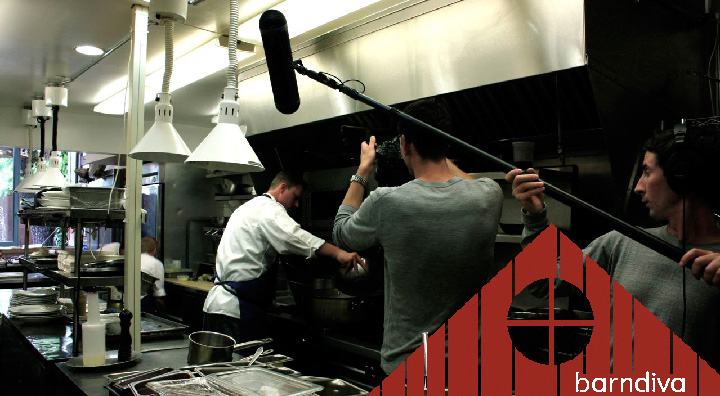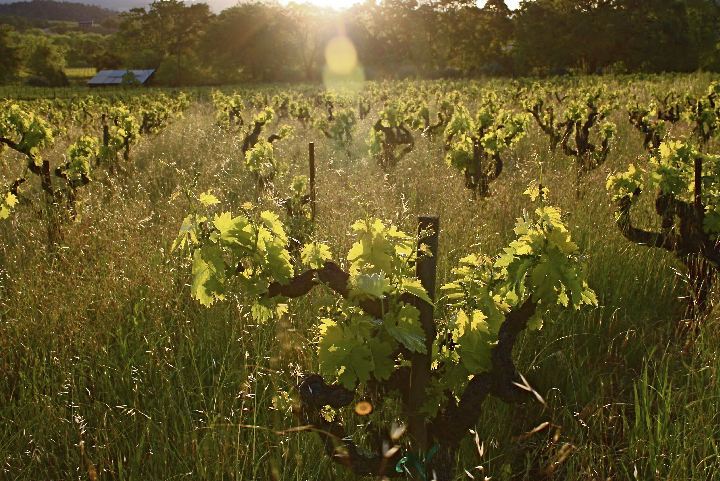Yes, but what makes it art?
Like it or not, we are all defined to a large extent by the landscape we live in. If on a molecular level you are what you eat, on an emotional level you are what you look at every day.
A landscape does not have to be beautiful to feed you (though it helps) so long as you have a true relationship to it, and crucially, the people who live in it with you. Solitude is nice but only through an honest connection to community can we change our outlook, and, in effect, our lives as a whole. Sometimes in ways we never imagined.
Until we moved to Healdsburg 10 years ago I really only took note of the Sonoma countryside in passing. It was beautiful, of course, but then so were similarly stunning vistas I’d traveled through. Even in Italy and France, once you take out the castles and gorgeous old villages, after a while vineyards are vineyards are vineyards.
The truth of how differently I feel now, living in and from this foodshed for almost a decade, was brought home to me all last week as I crept from a warm bed to leave the barn before dawn and travel from one end of the county to the other capturing raw footage for a video I’m making with Drew Kelly. Farm to Table in 3 minutes will tell the story of one plate of food as the ingredients travel to reach the table here at Barndiva. Foraged and farmed, made from animals that share the view with us, the dish relies entirely upon products that were sourced from people who would not normally consider themselves artists. In my view they are, contributing to a final dish which on every compositional and sensory level form a complete, if transitory, work of art. Let me explain.
Drew and I have wanted to work together again ever since he documented A Taste of Place for us at the Studio two years ago. Laura Parker’s exhibit had fascinating aesthetic and interactive components to it ~ smelling the soil as you eat the food grown from it is pretty sensate stuff ~ but Salon des Sens, the upcoming group show where we will premiere FT3minute has a decidedly different MO. It’s SF curator, Maggie Spicer, while not denying that all food is political, is an art first girl whose distinct vision for the show is an exploration of the ways in which, in the right hands, food can be used to create an authentic aesthetic experience. Towards this goal she has invited 15 Bay Area artists to participate, including four from Studio Barndiva. They work in a variety of media ~ photography, watercolor, acrylic, wire, compost and sod. Ryan, Drew and I have joined this group with the aforementioned video. Ryan will also be creating edible "works" which will be served on opening night.
We felt compelled to contribute to the show because while everything we do at Barndiva is made manifest by the fields and farms which surround us, even with the rise in popularity of the term Farm to Table very few people who come across a restaurant like ours for the first time have a real understanding of what it means. Lately, Ryan and I have even begun to wonder if "farm to table" isn’t growing into just another misappropriated catchword hard on the heels of "artisan" and "handcrafted."
Drew gets this. He comes to the discussion from a perspective of someone who creates art to tell a story, a talented imagesmith who is also a passionate eater and crucially, a new father, trying to make sense of this very complicated subject.
And so it was that we found ourselves crouched in the old vines in front of Lou and Susan Preston’s house at 6:30 on Friday, just as the sun was coming up. The day before we had followed Alex Lapham, who manages the vegetable program for Mix Gardens, as he went on his rounds harvesting fennel, wild garlic, favas, rapini and chive flowers ~ all crucial ingredients in the dish that would be the star of our video. It had been cold, gray and wet, not remotely sensuous in the Maggie Spicer sense of the word. Farming is hard work, by turns sweaty, grueling, repetitive. As much as you can you rely on experience, knowing full well that weather and dumb luck will ultimately control the cards you play.
 If the video is to be a success we knew we needed to connect the line that exists between the muck of a compost heap and a sculpted, beautiful vegetable presented on a gleaming white plate. Unlike any other artistic medium where raw product ~ a lump of clay or paint or steel ~ stays inert until the hand of the artist gets involved, everything about the final dishes we present on our plates, the way they look and taste and smell, starts in the field. This is our message: that everything about beautiful food ~ what it does to our senses when we take it in visually, breath it, open our mouths and suckle its taste ~ is inherent in the initial thrust of the shovel that starts the process to bring it along the food chain to us. In this regard, talent and vision and a steely focus come into play, marking the difference between grass fed beef and pink slime just the same as a lump of paint in different hands produces work as various as Vermeer to Kincaid. It is truly an art form where what you see at the end is set in place at the beginning. All the aesthetic components like shape, color and texture exist from the beginning in unadulterated form. The beauty of the process, what makes it art, relies on a partnership of artisans who alter and inform the material at every step as it winds its way to that last set of hands, waiting in the kitchen.
If the video is to be a success we knew we needed to connect the line that exists between the muck of a compost heap and a sculpted, beautiful vegetable presented on a gleaming white plate. Unlike any other artistic medium where raw product ~ a lump of clay or paint or steel ~ stays inert until the hand of the artist gets involved, everything about the final dishes we present on our plates, the way they look and taste and smell, starts in the field. This is our message: that everything about beautiful food ~ what it does to our senses when we take it in visually, breath it, open our mouths and suckle its taste ~ is inherent in the initial thrust of the shovel that starts the process to bring it along the food chain to us. In this regard, talent and vision and a steely focus come into play, marking the difference between grass fed beef and pink slime just the same as a lump of paint in different hands produces work as various as Vermeer to Kincaid. It is truly an art form where what you see at the end is set in place at the beginning. All the aesthetic components like shape, color and texture exist from the beginning in unadulterated form. The beauty of the process, what makes it art, relies on a partnership of artisans who alter and inform the material at every step as it winds its way to that last set of hands, waiting in the kitchen.
And the partners don’t just work together, mano a mano. They are also engaged in a profound partnership with the land and with the animals on it that fertilize, till and feed off it. There's magic in these relationships. If we do it right, FT3minute will cast a spell, the way only art can when it moves us. Alex bending in the soft gray light coaxing exquisite color from his vegetables, Liam reaching into a vat of steamy ricotta with the deft grace of a dancer, Lou’s maestro conducting of his sheep, Daniel moving up a forest road filling his basket with foraged nettles like a character out of a Thomas Hardy novel. Even Earl, talking to his hens, giving them a gentle push to get to their eggs, when viewed through the lens of our camera evokes a complicated Coen Brothers relationship to his brood that is pure visual joy.
Does it matter that our audience eats the art? According to the preeminent performance artist of our times, Marina Abramović, the answer is no. We are all participants in potential aesthetic experiences that masquerade as daily life, even if we don’t immediately recognize them as such. When you dine at Barndiva you buy a ticket to experience the talent of dozens of food artisans who would not exist, could not exist, without your patronage.
Or so I sat thinking, as the three of us waited in silence for the Preston sheep to come down the road. They would be lead by Giuseppe, the great white Maremma dog who lives with them from the day they are born. Following Lou’s instructions we were stationed off the road so as not to startle them. Nathan Cozzolino, our intrepid soundman who had traveled up from LA to work with Drew was to my left, crouching in the tall grass wearing serious looking headphones, his mic suspended on a tall pole. Drew, to my right, had set up a camera on a tripod directly across the road from the open gate to the olive field where the sheep would make their final pasture.
The grass grows high around the vines in Lou’s biodynamic vineyards, feeding the soil, creating an aerial meadow of insect sounds, more buzz than bite. When the wind picks up there is a sea swish that roils, softly, the pure definition of what it means to whisper. A cat, one of Susan’s half wild brood, jumped up on a vine to complain about something. Nathan, hearing everything in amplification, pointed up at the sky, where a curious Heron circled low.

And then we heard them coming. I’ve been in places where shepherds have the right of way on small country roads but this was different, a singular procession lead by a dog with all the dignity of a Catholic Priest leading a flock of keening mourners. Perhaps because art was on my mind, references abounded: the light on the landscape was Turneresque, the passion play had all the irony of Chaucer, the cacophony of bleating pure Philip Glass. Marina would have loved what I did with the moment.
But was it art? While the cohesive parts that would make it whole were yet to come ~ Ryan breaking the animal down, the many hours of prep and cooking our staff would put into all the other ingredients before Ryan returned to arrange the elements on the plate in his inimitable style ~ yes, I’d argue that is was. What we filmed at dawn was as integral to the process of the finished piece as a composer picking up his pencil to jot down some notes long before the orchestra gets them, before the sound of a single virtuoso violin can wing its way through the air in some palace of fine arts.
But then, I love to argue. So come see for yourself and you decide. Salon des Sens, a Food Art Show, opens on June 2. Our talented friends at St. George spirits will be collaborating with Rachel on exciting new cocktails; Copain Winery will be pouring their extraordinary wines.
Are cocktails like ours which are made from beautiful spirits considered artful? Is wine? Don’t get me started.
Salon des Sens is coming...click for details to the show and opening party!
The Jazz Festival returns to Barndiva
And Finally...
All text Jil Hales. All photos Jil Hales (Susan Preston's hand, Drew Kelly).











